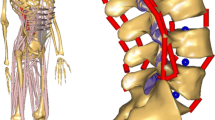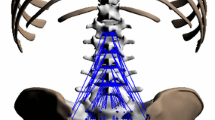Summary
The body's equilibrium is possible thanks to the integration of skeletal structure, vertebrae, ligaments and muscles to form one functional unity.
The forces which determine posture are composed of two complementary systems, the ligamentary and the muscular systems, which together determine a dynamic act of balance.
The ligaments operate mainly against the visco-hydraulic pressure of the nucleus pulposus and bind the vertebral bodies together, whereas the muscles exhibit an antigravity function and support spinal stability.
A mathematical model based on a mixed theory of directed and oriented curves is proposed. Through this model it is possible to develop an exact theory governing the deformation of the ligamentous spine. This theory should be universal in the sense that it can be used to study the spine in any of its environments.
Zusammenfassung
Die aufrechte Körperhaltung wird physikalisch durch das ossäre, das muskuläre und ligamentäre Kräftesystem gekennzeichnet. Alle diese Systeme streben in der Normalhaltung ein Gleichgewicht an.
Es wird aufgrund einer einfachen, nicht linearen Theorie ein mathematisches Modell gezeigt, welches das mechanische Verhalten des osteoligamentären Anteils der Wirbelsäule auf Längs- und Schubdehnung, Biegung und Verdrehungsdeformation darstellt.
Similar content being viewed by others
References
Ewing, C. L., King, A. I., Prasad, P.: Structural considerations of the human vertebral column under +Gz impact acceleration. J. Aircraft 9, 84–90 (1972)
Hess, J. L., Lombard, C. F.: Theoretical investigations of dynamic response of man to high vertical accelerations. J. Aviat. Med. 29, 66–74 (1958)
Hirsch, C.: Biomechanics in motor skeletal structures. Sym. on Biodynamic Models and Their Applications, Wright-Patterson Air Force Base, Doc. No. AMRL-TR-71-29 (1970)
Krause, H.: Das schwingungsmechanische Verhalten der Wirbelsäule. Int. Z. angew. Physiol. 20, 125–155 (1962)
Krause, H. E., Shirazi, M.: The transverse response of the lumbar spine under longitudinal loads. Sym. on Biodynamic Models and Their Applications, Wright-Patterson Air Force Base, Doc. No. AMRL-TR-71-29 (1970)
Latham, F.: A study of body ballistics: Sea ejections. Proc. roy. Soc. B-147, 121–139 (1957)
Li, T. F., Advani, S. H., Lee, Y. C.: The effect of initial curvature on the dynamic response of the spine to axial acceleration. Sym. on Biodynamic Models and Their Applications, Wright-Patterson Air Force Base, Doc. No. AMRL-TR-71-29 (1970)
Liu, Y. K., Murray, J. D.: A theoretical study of the effect of impulses on the human torso. Proc. ASME Sym. on Biomechanics (ed. Y. C. Fung), 167–186 (1966)
Lucas, D. B., Bresler, A. H.: Stability of the ligamentous spine. Biomech. Lab. 40 (1961)
Murray, J. D., Tayler, B. A.: An asymptotic solution of a class of nonlinear wave equations: A model for the human torso under impulsive stress. SIAM J. App. Math. 18 (1970)
Orne, D., Liu, Y. K.: A mathematical model of spinal response to impact. J. Biomech. 4, 49–71 (1971)
Prasad, R., King, A. I.: An experimentally validated dynamic model of the spine. J. App. Mech. 41, 546–550 (1974)
Rizzi, M. A., Whitman, A. B., DeSilva, C. N.: A mathematical model of the spine based on mixture theory of directed curves. Acta Mechanica 21 (1975)
Rizzi, M. A., Whitman, A. B., DeSilva, C. N.: Einige Betrachtungen über ein biomechanisches Modell der Wirbelsäule. ZAMM 55, 739–746 (1975)
Seigel, A. E., Waser, R. H.: On the use of a spring mass to approximate a bar mass system subjected to a rectangular force pulse. Int. J. Sol. Struct. 5 (1969)
Stech, E. L.: Calculation of the human spinal frequency from cadaver data and comparisons with tests on live subjects. Frost Engr. Development Corp., Rep. No. 122–100 (1963)
Terry, C. T., Roberts, V. L.: A viscoelastic model of the human spine subjected to +Gz acceleration. J. Biomech. 1, 161–168 (1968)
Toth, R.: Multiple degree of freedom nonlinear spinal model. 19th Annual Conf. on Engr. in Med. and Biol., San Francisco, Calif. 1967
Vulcan, A. P., King, A. I., Nakamura, G. S.: Effects of bending on the vertebral column during +Gz acceleration. Aerospace Med. 41, 294–300 (1970)
Yorra, A.: The investigation of the structural behavior of the intervertebral disc. Master's Thesis, MIT (1963)
Author information
Authors and Affiliations
Rights and permissions
About this article
Cite this article
Rizzi, M.A., DeSilva, C.N. On modeling the ligamentous spine philosophy and implementation. Arch orthop Unfall-Chir 86, 219–226 (1976). https://doi.org/10.1007/BF00415333
Received:
Issue Date:
DOI: https://doi.org/10.1007/BF00415333




